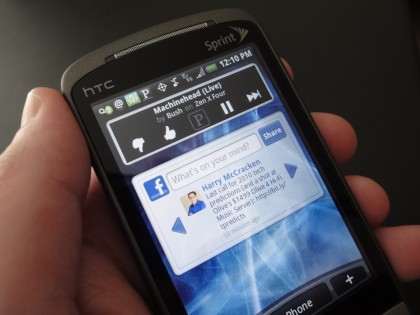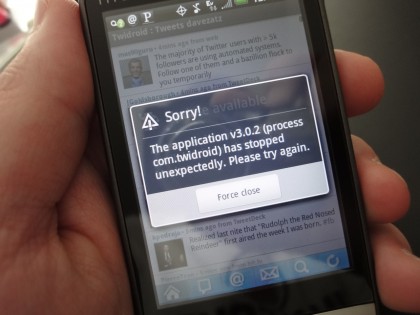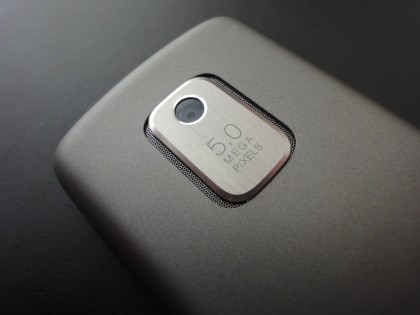After several weeks of surfing with the alien# living with the Android, I’m comfortable declaring any build 1.5 or higher as a suitably modern, powerful mobile OS that will meet the needs of most. In addition to carrying Sprint’s rendition of the HTC Hero (along with my iPhone 3GS), I’ve also had the opportunity to play with a few office Droids. While Android (even 2.0) isn’t nearly as polished as the iPhone OS, there are several compelling enhancements that ‘droid does.
Multitasking is the most obvious. And something many like me have been effectively managing since the Windows PocketPC days. Being able to continue streaming Slacker while checking email? Priceless. Unlike the iPhone home screen, in addition to application icons, Android also provides support for folders and widgets (as shown above). Lastly, Android conveniently collects various configurable system/app notifications in a drop down bar.
Compared to the iPhone ecosystem, the Android Market app store has many fewer options. More importantly, even the top apps don’t exhibit the same level of quality found in the iTunes App Store. Twitdroid is no Tweetie. (And Facebook is no… Facebook.) On the other hand, new apps and updates are continually flowing without a gatekeeper like Apple gumming up the works. But that sometimes results in flakey, crashy, error-prone apps. You can’t have your cake and eat it too. However, I expect the app situation will quickly improve as Android’s footprint explodes, drawing more companies and professional developers into the game.
Specific to the Sprint Hero, I dig HTC’s slick Sense UI skinning. Some of their pre-packaged apps are attractive and useful as well. But, on the hardware front, I can’t say I love the design. The chinny European version has more personality and the front metal plate seems a bit incongruous. However, I do appreciate a nice backside. (What?!) And the minimalist soft-touch finished rear, barely blemished by the 5 megapixel camera surrounded by speaker grills, appeals. Overall, I had excellent reception and coverage. As you might expect from my unscientific testing, Sprint’s network seems more accessible in more places than AT&T’s.
As much as I enjoyed Sprint’s coverage and Android on the Hero, I’d advise power users to consider picking up a Motorola Droid (Verizon) at this point. While I find the Droid’s flat physical keyboard useless, its processor is significantly more powerful than what’s found in the Hero, Eris, and myTouch – all of which are a step too slow. (I ran a few side by side tests – the differences were most clearly apparent when flipping the screen orientation.) But, if you can hang tight a little longer, between CES (early January) and the Mobile World Congress (mid February), I anticipate seeing quite a few new Android device introductions– many running on the superior Snapdragon platform.
Click to enlarge:



At the Best Buy last weekend, I noticed a multi-carrier Android brochure, which is what those two extra pics are. Unfortunately, it got a little wet in the rain and the photo lighting sucked. Sorry I wasn’t motivated to swing back by for a replacement brochure or shoot better pics.
Thanks Dave,
I’ll be sticking with my iPhone for the moment. Can only hope we’ll see one on Verizon in the coming year before my contract with AT&T is up. However, I’ll be watching the Android market closely, and if things go as expected its possible I’ll switch.
There are many things I’d miss of course–all the docks, including the ones in my car, in fact all of the ecosystem around the iPhone will be hard to copy with so many Android variants. Would love to get that bedside Droid multimedia dock though. Maybe one of the Android phones will get enough of a following that some of this will come with it.
I’ll need a lot of the same software of course. I need WebEx, which hopefully will be coming. And some good games. And Secret! And a better Twitter client. And Exchange support. And a Sling client. And LogMeIn. And …
I assume all of that will come with numbers though, and there are advantages as you say. Being able to watch my Slingbox video over 3G maybe. Or use it in Tethered mode from my laptop, banishing that 3G dongle and its $60/month charge. And free Google Maps navigation with crowd-sourced traffic, which I’d prefer over the Navigon app I paid for on my iPhone.
We’ll have to see. Competition is good.
I know the Droid has a newer processor, but I’d heard that Android 2.0 should offer significant speed enhancements, particularly in home screen navigation and wait time. Are you not buying into that story?
Sense is nice, but I wish it didn’t take so long for HTC to release updates. By the time we get 2.1 I’ll be lusting after 3.2
Good review! That’s what I was looking to hear about, especially the GUI.
interesting advice. we may be removing out dated BES 4/Exchange 2003 server because it will be cheaper to buy everyone droids and check mail on our primary imap server than to upgrade exchange and BES
damnit, i just bought a storm2.
Any word of an HTC Sense phone with a physical keyboard, maybe similar to the heralded heyboard on the Touch Pro 2? It’s the only thing keeping me from getting the Hero.
What’s interesting is that a lot of the SenseUI skins and home screen options can be replicated pretty easily using various apps in the Market. The customization possibilities are impressive.
Already, someone has figured out a way to replace the stock Droid eye startup with the fancy colors used in the NexusOne startup. The geek in me loves stuff like that!
Dave, glad to have you over here on the Android darkside. ;) But of course, now that you have embarked on the Android lifestyle, you really need to go that extra step and root your phone to try out some of the hacker mods. They’re very cool, and generally have proven to be quite stable.
Have to have a Sonos app. Dealbreaker without.
jeadly, I did assume there might be some software optimizations to eek out better performance. But I also figured that might be partially offset by richer transitions and such. My ultimate conclusion was based on the Hero processor being outdated, the same processor seen in the G1 which could be considered old by mobile standards (keeping in mind it was released overseas before the US, pushing the date further back). The bottom line is that I’d rather have next years processor versus last years, if I only have to wait a month or so.
Glenn, yah for people dependent on specific, existing iPhone apps making a move could be more challenging. I’m pretty simple though – give me a decent web browser, contacts, email, nav, and Twitter and probably 90% of my needs will be met.
jon, not sure if the Exchange support on Droid is an issue. I seem to recall reading/hearing something. Of course, they should be motivated to get that right efficiently.
Bruce, this was a loaner from Sprint which I didn’t want to give back yesterday. If the right hardware on the right carrier shows up in the next month or so, I’d be comfortable leaving AT&T behind. At least until the iPhone 4.0 arrives. (I’m also curious to see if Palm has any further tricks up their sleeves.)
Marte, The Sonos folks tell me support for two new mobile platforms is coming next year. I think it’d be pretty easy to predict which…
I will picking up an unlocked Nexus 1 in January, popping the sim out of my iPhone and dropping it in the N1. Then I will pass the glorified gameboy, aka iPhone 3GS, to my kid for his entertainment.
Why does Harry get the plug? hehe
I must say though, very impressed with the recent Android phone releases. I think we truly have the first iPhone competitors on the market. WinMo what? :)
“…even the top apps don’t exhibit the same level of quality found in the iTunes App Store. Twitdroid is no Tweetie. ”
Dave did you try the new Twitter mobile site just using the browser?
http://mobile.twitter.com
Way better than the old one ( m.twitter.com ) and I use it exclusively, shunning local Twitter clients.
As far as “same level of quality”, that statement is slightly unfair if you are mis-matching products. Twidroid is no Tweetie because Tweetie developers have made the decision not to port the app – you cannot blame Android for that. Not to mention, Twidroid is free, Tweetie is not.
I ask that you compare, for example, the iPhone Foursquare app directly with the Android app, and then compare other apps that have proper parity. There are others that have iPhone and Android apps from the same company, like Ustream, Last.FM and Shazam, and…
…Google Voice, er, oops, no iPhone equivilant on that one.
;)
For anyone on Sprint, the Samsung Moment is a decent substitute for the Droid if you want a physical keyboard and don’t want to (or can’t) leave Sprint. It’s only Android 1.5 for now, but 2.1 is coming in H1 2010. So we have that going for us, which is nice.
I have a Moment and it works well, apart from the dismal battery life issues that have been well documented online. Power management is hard. :-)
Can’t go back to my old Moto Q9c and WinMo 6.1. Can’t do it. Will stick it out with the dismal battery life for a year when hopefully more Android phones with better performance and power management will be out.